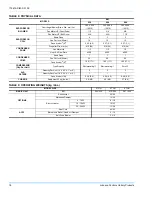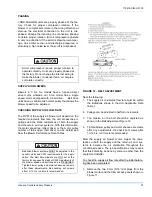
175619-XIM-C-0109
Johnson Controls Unitary Products
31
ing is still present at the conclusion of the ASCD, the
UCB will re-energize the compressor.
Should a freezestat open three times within two hours
of operation, the UCB will lock-out the compressor and
flash a code (see Table 8).
LOW AMBIENT COOLING
To determine when to operate in low ambient mode,
the UCB has a pair of terminals connected to a temper-
ature-activated switch set at 45ºF. When the low ambi-
ent switch is closed and the thermostat is calling for
cooling, the UCB will operate in the low ambient mode.
Low ambient mode operates the compressors in this
manner: 10 minutes on, 5 minutes off. The indoor
blower is operated throughout the cycle. The 5-minute
off period is necessary to defrost the indoor coil.
Low ambient mode always begins with compressor
operation. Compressor minimum run time may extend
the minutes of compressor operation. The defrost cycle
will begin immediately following the elapse of the mini-
mum run time.
When operating in low ambient mode, the UCB will not
lockout the compressor due to a freezestat trip. How-
ever, a freezestat trip will de-energize the compressor.
If the call for cooling is still present at the end of the
ASCD and the freezestat has closed, the unit will
resume operation.
SAFETY CONTROLS
The unit control board monitors the following inputs for
the cooling system:
1.
A suction line freezestat to protect against low
evaporator temperatures due to a low airflow or a
low return air temperature, (opens at -3°C (26°F)
and resets at 3°C (38°F)).
2.
A high-pressure switch to protect against exces-
sive discharge pressures due to a blocked con-
denser coil or a condenser motor failure, (opens at
2660 kPa gauge (380 psig) and resets at 2068 kPA
gauge (300 psig).
3.
A low-pressure switch to protect against loss of
refrigerant charge, (opens at 48 kPa gauge (7 psig)
and resets at 154 kPa gauge (22 psig).
The above pressure switches are hard-soldered to the
unit. The refrigeration system is monitored and con-
trolled. On any fault, the system will be affected by any
safety/preventive action.
The unit control board monitors the temperature limit
switch of the electric heat.
COMPRESSOR PROTECTION
The compressor also has inherent (internal) protection.
If there is an abnormal temperature rise in a compres-
sor, the protector will open to shut down the compres-
sor. The UCB incorporates features to minimize
compressor wear and damage. An anti-short cycle
delay (ASCD) is utilized to prevent operation of a com-
pressor too soon after its previous run. Additionally, a
minimum run time is imposed any time a compressor is
energized.
The ASCD is initiated on unit start-up and on any com-
pressor reset or lock-out.
FLASH CODES
The UCB will initiate a flash code associated with
errors within the system. Refer to UNIT CONTROL
BOARD FLASH CODES Table 8.
RESET
Remove the call for cooling, by raising thermostat set-
ting higher than the conditioned space temperature.
This resets any pressure or freezestat flash codes.
HEATING SEQUENCE OF OPERATIONS
WITH OR WITHOUT ELECTRIC HEAT
When the thermostat calls for the first stage of heating,
the low voltage control circuit is completed between “R”
and “W1”. The 24vac signal is passed through the
UCB to the “Y” contact on the Defrost Control (DC)
assuring the reversing valve cannot be energized,
except during defrost. If the ASCD timer is satisfied the
UCB will energize compressor contactor M1.
If the compressor alone cannot satisfy the heating
requirements, a second stage call from the thermostat
completes the circuit between “R” and “W2”. This
24vac signal is passed through the UCB to the electric
heat section (if available). The total available kW of
electric heat will be energized on a call for “W2”.










































